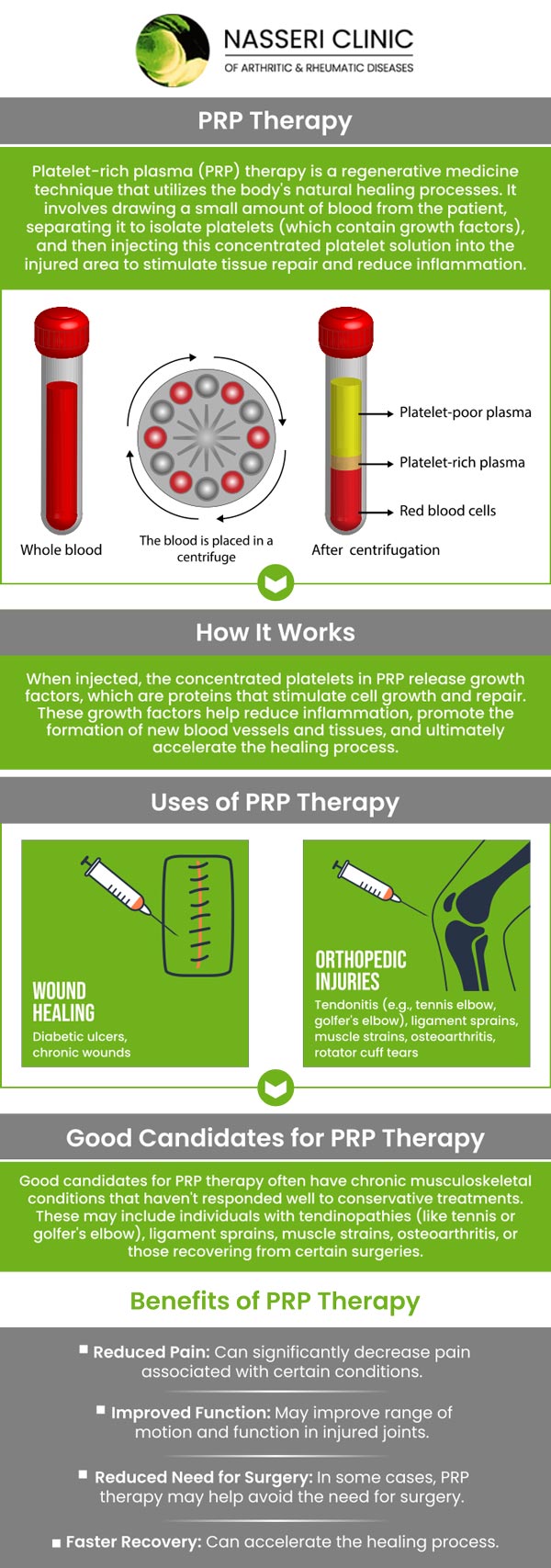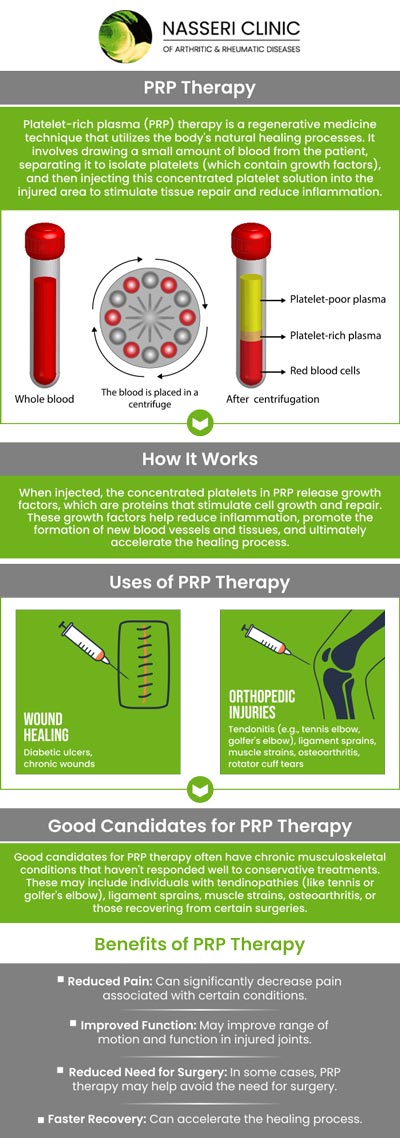How PRP Injections Help with Joint Pain
PRP injections help alleviate joint pain by using the body’s own platelets to promote tissue repair, reduce inflammation, and stimulate healing. This natural approach can provide relief for patients with joint pain caused by conditions like arthritis, tendinitis, and ligament injuries. Visit Dr. Nasseri, MD, Dr. Ebrahim Talebi, MD, and their caring staff to improve joint function. For more information, contact us or book an appointment online. We have convenient locations to serve you in Rosedale, Columbia, Glen Burnie, North Baltimore, Edgewater, and Catonsville MD.


Table of Contents:
How long does it take for PRP to work on joints?
What are the benefits of PRP treatment for joint pain?
What should I do after a PRP injection for joint pain?
How soon can I go back to regular physical activities after PRP treatment for joint pain?
At Nasseri Clinic of Arthritic and Rheumatic Diseases, we offer innovative treatments like Platelet-Rich Plasma (PRP) therapy to help manage conditions such as osteoarthritis, rheumatoid arthritis, tendonitis, and ligament injuries.
How PRP Therapy Works
PRP therapy uses a sample of the patient’s blood, which is processed to concentrate the platelets. This enriched plasma, containing growth factors, is then injected into the affected joint to stimulate tissue regeneration, reduce inflammation, and enhance healing. This approach is especially effective for chronic pain and inflammation linked to arthritis and rheumatic diseases.
Expected Timeline for Relief
Patients typically experience pain relief and improved mobility within a few days to several weeks post-injection, depending on the condition’s severity and individual factors like age and health. Our team tailors treatment plans to meet each patient’s needs.
Long-Term Benefits
Peak benefits are usually seen within 4-6 weeks, with continued improvements over 3-6 months. Some patients experience lasting relief for years, though additional injections may be needed for sustained results.
Factors Influencing Efficacy
The effectiveness of PRP can depend on factors such as the severity of the condition, overall health, and age.
At the Nasseri Clinic of Arthritic and Rheumatic Diseases, we offer advanced treatments like Platelet-Rich Plasma (PRP) therapy to help manage joint pain and improve quality of life, especially for those with arthritic and rheumatic conditions. PRP therapy involves using a concentrated form of platelets from the patient’s own blood, which are rich in growth factors and proteins that support the body’s natural healing processes.
This therapy helps reduce inflammation, promote tissue repair, and improve joint mobility, providing relief from pain and allowing patients to resume daily activities more comfortably. PRP can also stimulate collagen and cartilage production, crucial for maintaining joint health, particularly in conditions like osteoarthritis where traditional treatments may fall short.
As a minimally invasive alternative to surgery, PRP therapy offers a safer, less risky option for many patients. It may even delay or eliminate the need for surgical interventions. At Nasseri Clinic, our goal is to enhance joint function, reduce pain, and support faster recovery with this innovative, personalized treatment approach.
At Nasseri Clinic of Arthritic and Rheumatic Diseases, we offer Platelet-Rich Plasma (PRP) injections to harness the body’s natural healing processes for joint pain relief. To ensure the best results, following post-injection care is essential.
Immediate Post-Injection Care:
• Rest the affected joint and avoid strenuous activities for at least 48 hours.
• Use ice packs on the injection site for 20-30 minutes multiple times daily to reduce swelling.
• Elevate the joint to decrease swelling.
Activity Restrictions:
• Gradually increase activity, avoiding high-impact or joint-stressing activities for 4-6 weeks.
• Your provider may recommend gentle range-of-motion exercises after the initial rest period.
Pain Management:
• Use acetaminophen for pain relief; avoid NSAIDs like ibuprofen or aspirin for 24 hours to prevent interference with the PRP’s healing effects.
• Contact our clinic if you experience severe or persistent pain.
Additional Considerations:
• Avoid smoking and alcohol, as they can hinder healing.
• Stay hydrated and maintain a nutrient-rich diet to support recovery.
• Attend follow-up appointments for progress monitoring and treatment adjustments.
By following these guidelines, you can maximize the benefits of PRP therapy for optimal joint recovery.
At Nasseri Clinic of Arthritic and Rheumatic Diseases, we offer Platelet-Rich Plasma (PRP) therapy to help alleviate joint pain from arthritic and rheumatic conditions. After treatment, we provide a personalized post-treatment plan to ensure optimal recovery and a safe return to daily activities.
Initial Recovery Phase:
Patients are advised to rest the treated area for 24 to 48 hours. Mild discomfort or swelling is normal as the PRP begins repairing tissues. Gentle range-of-motion exercises may be recommended to improve circulation and reduce stiffness.
Gradual Increase in Activity:
In the following days, light activities like walking are encouraged, but high-impact exercises such as running or heavy lifting should be avoided for at least one to two weeks.
Progressive Rehabilitation:
By weeks three to four, many patients can gradually reintroduce more intense activities, guided by our healthcare team or physical therapist. The rehabilitation plan will be tailored to each patient’s condition to ensure the best possible recovery and long-term benefits.
Our team works closely with patients to ensure safe, effective healing throughout the process.
At the Nasseri Clinic of Arthritic and Rheumatic Diseases, we advocate for a cautious and gradual approach to resuming physical activities post-PRP treatment. Our patients are encouraged to follow the tailored guidance provided by our healthcare professionals, prioritize rest and recovery, and promptly communicate any concerns for the best possible outcomes. For more information, contact us or request an appointment online. We serve patients from Rosedale MD, Columbia MD, Glen Burnie MD, Catonsville MD, North Baltimore MD, Edgewater MD, Parkville MD, Middle River MD, Dundalk MD, Halethrope MD, Ellicott City MD, Laurel MD, Hebbville MD, and Woodlawn MD.

Additional Services You May Need

Additional Services You May Need
▸ Arthritis Care
▸ Infusion Therapy
▸ Lab Services
▸ Radiology
▸ NCARD NRACE
▸ BioFlex Laser Therapy
▸ Ultrasound Guided Injection
▸ NCARD PRP
▸ NCARD Myers
▸ Rheumatology
▸ Myositis
▸ Osteoporosis
▸ Ulcerative Colitis
▸ Multiple Sclerosis
▸ Saphnelo Infusion
▸ Injection Treatments
▸ Intravenous Immunoglobulin Therapy
▸ Asthma
▸ Crohn’s Disease
▸ Fibromyalgia
▸ Infusion Therapy for Gout
▸ Inflammatory Eye Disease
▸ Inflammatory Skin Disease
▸ Vasculitis
▸ Iron Deficiency
▸ Lupus


